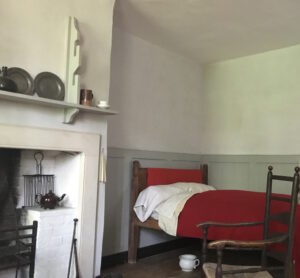During the October 24, 1806 inventory in the workhouse of Staplehurst Kent, some “Blue Furniture” would have created a splash of color in the “Nursery Chamber.” In this case, furniture refers to fabric or linens, most likely those used as a bed curtain.
One way to display this fabric in a museum would be on a bed frame. Let alone, the furniture would remain shapeless and not evoke the shelter it might have given to inmates experiencing childbirth or illness in the workhouse. Visitors could even climb into a model bed to experience the curtains surrounding them.
However, hanging this fabric on a physical bed in a museum exhibit fixes its meaning. As Bayne, Ross, and Williamson note, “Where the material object is stable in time and space, the digital object is both mobile and volatile” (112). Using a digital tool might enable visitors to manipulate the fabric themselves, and explore how it might function as covers, as window curtains, or even as repurposed cloth for rags. Even the scenario I describe limits interpretations, but it might begin to transfer the opportunity to interpret into the audience’s hands.
Sources:
Bayne, Siân, Jen Ross, and Zoe Williamson. “Objects, subjects, bits and bytes: learning from the digital collections of National Museums.” Museum and Society 7, no. 2 (July 2009): 110-124. ISSN 1479-8360.
“An Inventory of All and Singular the Good and Chattels of the Work-house of the Parish of Staplehurst Kent as taken the 24th of October 1806 by order of the Overseers Messrs Ts. Simmons & Ts Bromley at the Death of the late Master Daniel Axell.” Kent Library P.347/18/1.
